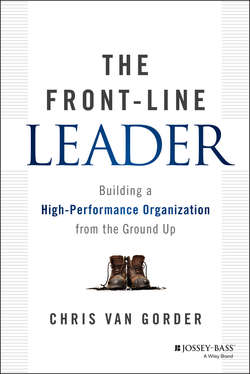Читать книгу The Front-Line Leader - Gorder Chris Van - Страница 7
На сайте Литреса книга снята с продажи.
Chapter One
Know Your People
ОглавлениеI have this old, embarrassing photograph of myself wearing a Native American headdress. It's shoved into my desk drawer. Even though the corners are bent and I've got this big, silly grin on, the picture means as much to me as any of the framed images featuring famous people that line my office walls. The photograph dates from 1987, when I was vice president for support services at Anaheim Memorial Hospital in Anaheim, California. It was my first vice president job, and it put me in charge of an array of departments including environmental services (or housekeeping, as it was called back then), food services, engineering, and construction.
I made a practice at the time of meeting regularly with all of my staff, including the environmental service (EVS) workers. I'd go down to the EVS break room and say hello when employees were coming on duty and getting assignments for the shift. I wanted to know what my employees did; otherwise, I felt, I couldn't be an effective manager. I had learned as a police officer that if you wanted to get information about your beat, you had to be on the street talking to people. You had to develop rapport and trust, and after a while people would naturally start talking to you and telling you what they knew.
Sometimes I just sat and talked with the EVS staff; other times I went out and accompanied them on the job. They taught me how to use those big, circular floor polishers, and every time I grasped the metal handles I was bucked around, much to their amusement. I didn't mind making myself a little vulnerable. Given how hesitant the employees acted around me and also how happy they seemed to see me, I surmised that I was probably among the few people from senior management to ever pay sincere attention to them.
As time passed, we built a relationship. The staff invited me to potlucks and other gatherings. “My boss's boss's boss knows more about what I do than my boss does,” they would joke. They also challenged me to see if I could find dirt after they cleaned. “You guys are so good,” I said, “I bet I can't find any.” But I would still put on white gloves and poke around. A couple of times, to be honest, I did find a little bit of dirt on the gloves, but I never let them know. The point of this exercise was not for me to evaluate their performance. It was about going out there, showing I cared, and thanking the team for its hard work.
One day, a couple of the workers knocked on my door and asked me to accompany them to the break room. When we arrived, I found that all the employees had gathered. With smiles on their faces, they presented me with a Native American–style headdress they had made out of fur. It had two pointy horns protruding out of the top, a blue and red beaded design running across the front, and fluffy white feathers streaming down each side.
I held it in my hands and admired it. “This.. is very nice. What is it?”
“This is for you,” they said proudly. “Our chief.”
Everyone applauded, and I didn't know what to say. What an incredible honor. Today, in addition to keeping that photograph in my drawer, I display the headdress in my office as a reminder of what I learned: that you can't be a distant boss and hope to be effective as a leader. You have to connect with people. You have to put time and energy into getting to know them and their work. Not just once. Or twice. Or three times. But regularly, month after month.
